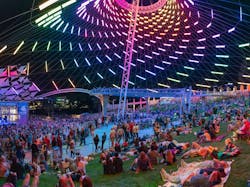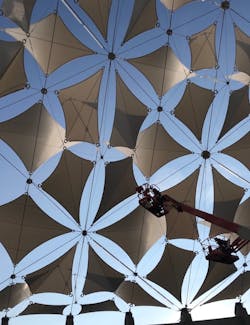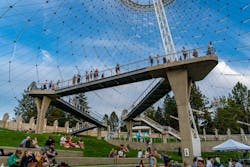Spokane Riverfront Park U.S. Pavilion project creates a refreshed gathering place in Spokane
Situated at the center of Riverfront Park on Havermale Island in Spokane, Wash., the U.S. Pavilion had become a beacon of indecisiveness for the area. Built by the federal government for the 1974 World’s Fair, and gifted to the city of Spokane after, the vision of how to best utilize the space changed numerous times throughout the years without any one vision coming to fruition. This led to the pavilion grounds becoming cluttered with underutilized buildings and structures.
As part of a modernization project for Riverfront Park, the City of Spokane Parks and Recreation Department decided to update the pavilion and turn it into a central gathering point for hosting community-oriented events. The new U.S. Pavilion was also envisioned as a lantern at night, illuminated with state-of-the-art lighting and project technology to attract visitors and tourists.
The Pavilion comprises a 150-foot-tall, angled mast that supports a 50-foot diameter steel ring. A cable-net structure attached to the ring extends downward to a circular-buttressed concrete wall and columns. The cable-net structure was originally covered and resembled a large tent, but this cover was removed only a few years after construction after being shredded by the wind. For the new U.S. Pavilion, the Build Team decided to forgo the tent-like canopy, as it would have greatly compromised the ability for the structure to serve as a lantern at night, a decision that originally drew the ire of the public. But by clearly identifying and explaining the project’s goals of reconnecting to the river, providing illumination and shading, and creating an “Elevation Experience” that showcased the Park, the Build Team was able to win over the public.
On the west side, and integral to the concrete wall, is a 16,000-sf, two-story concrete building. The reimagined project scope included removing all buildings added after 1974, renovating the west building, and creating an amphitheater below the cable-net structure.
In order to achieve the goal of turning the Pavilion into a lantern, the Build Team, after cycling through many early design concepts such as stinging the cable-net structure with Christmas lights, settled on using light blades consisting of LED modules in a robust luminaire housing attached to the cable structure with flexible mounting points. The luminaire system was designed to be subjected to a wide range of weather and temperature changes, as well as vibrations in the cable structure due to tension and wind.
The luminaire housing was completed with etched acrylic panels, which were designed and tested to create the desired lighting effect without precision aiming, thereby reducing the complexity of maintaining the system. Because the light-blade luminaires can accommodate movements and flexing without the need to re-aim, the need to access the luminaires was reduced to almost zero.
In addition to the lighting, providing shading for the events was another key programming challenge. GuildWorks, a design-build tension structure specialist, recommended attaching shade elements to the existing cable-net structure by reverse engineering the 46-year-old cable structure using modern tension structure analysis. The team then engineered and constructed a new system of struts, tension cables, and tensioned shade fabrics to support 72 custom-designed architectural fabric panels.
The shade panels are located on the lower western section of the U.S. Pavilion cabling. During afternoon sun the panels provide shade in an artistic pattern, casting abstract, Pavilion-like imagery, while also enhancing the vision of patrons looking west toward the stage. Carefully locating the panels ensured that visitors remain in sunlight during the cooler parts of the day.
The Elevated Experience, meanwhile, was designed and built with four guiding principles in mind:
1. Make it a “magnetic” attraction that will draw visitors in
2. Celebrate and connect the iconic structure
3. Provide views of the city and the river
4. Make it feel a bit precarious and uncomfortable
The Elevated Experience became a unique public space where visitors ascend under their own power up narrow walkways with largely transparent railings and see-through gratings as a walking surface. The height of the pathways allow for both views of the surrounding city and river, as well as below to the pavilion floor and its events.
The completed project delivered a reimagined U.S. Pavilion that exceeded all expectations despite significant initial opposition and challenges.
PROJECT INFORMATION: Size 86,000 sf Construction start and finish December 2017 to August 30, 2019 Cost $24.7 Million Delivery method Design-Build
BUILDING TEAM: Submitting firm Hill International, Inc. Owner/Developer City of Spokane Parks and Recreation Department Architect NAC Architecture Architect of Record Berger Partnership SE DCI Engineers Mechanical nad Plumbing Engineer MW Consulting Engineers Electrical Engineer NAC Electrical and Lighting GC Garco Construction Program Manager Hill International, Inc.




